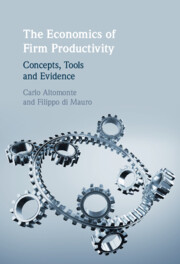Book contents
- Frontmatter
- Contents
- Figures
- Tables
- About the Authors
- Preface
- Acknowledgements
- 1 Introduction
- 2 Basic Concepts
- 3 Productivity Estimation
- 4 Measuring Market Efficiency
- 5 Sources of Data
- 6 Productivity and the Financial Environment
- 7 Productivity and the Labour Market
- 8 Productivity in a Borderless World
- 9 Productivity and Competitive Pressure
- 10 Conclusions
- Bibliography
- Index
8 - Productivity in a Borderless World
Published online by Cambridge University Press: 14 April 2022
- Frontmatter
- Contents
- Figures
- Tables
- About the Authors
- Preface
- Acknowledgements
- 1 Introduction
- 2 Basic Concepts
- 3 Productivity Estimation
- 4 Measuring Market Efficiency
- 5 Sources of Data
- 6 Productivity and the Financial Environment
- 7 Productivity and the Labour Market
- 8 Productivity in a Borderless World
- 9 Productivity and Competitive Pressure
- 10 Conclusions
- Bibliography
- Index
Summary
Firm heterogeneity is nowadays at the center of trade analysis. There seems to be a link between firms' presence on foreign markets and productivity of individual companies. There is a premium for companies engaging in internationalization activities against those serving only the local market, and these premia seem to increase with the complexity of the internationalization activity. There is causality between firms' innovation and internationalization activities. This implies that innovation policies are a major driver of trade and economic growth. Few firms are able to export, and export is thus very concentrated in a few firms in virtually all countries. This fact means that policymakers might be able to analyse and forecast nearly all aggregate trade figures by predicting a few firms' export value. Responses to exchange rate movements are heterogeneous across firms: export elasticity to REER movements is inversely correlated with size and productivity, and therefore exports by larger and more productive companies are less sensitive to exchange rate movements.
- Type
- Chapter
- Information
- The Economics of Firm ProductivityConcepts, Tools and Evidence, pp. 130 - 168Publisher: Cambridge University PressPrint publication year: 2022

